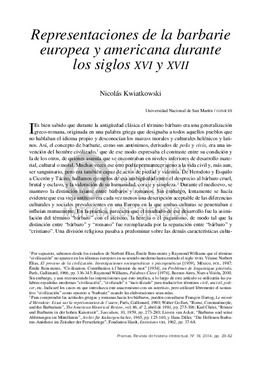Representaciones de la barbarie europea y americana durante los siglos XVI y XVII
Representations of European and American barbarity during the XVI and XVII Centuries
Abstract
El artículo propone un estudio de las representaciones visuales y textuales de la barbarie en la temprana modernidad, en busca de indicios de los recursos utilizados por los europeos de entonces para construir su propia identidad en relación, muchas veces conflictiva, con sus concepciones de los otros del Viejo y el Nuevo Mundo. De allí que se consideren especialmente los casos en que el vínculo con esos otros implicó reflexiones de diverso tipo sobre la propia existencia en el presente y en el pasado. Se estudia también el uso del término bárbaro en las relaciones entre ingleses e irlandeses a mediados del siglo XVII, cuando el uso de los conceptos “bárbaro” y “barbarie” estuvo entre los condicionamientos de la imposibilidad de toda empatía, la negación de la humanidad del adversario y, finalmente, una serie de matanzas y deportaciones descomunales. The article studies visual and textual representations of barbarity in Early Modern Europe, in an attempt to trace the ways in which identity was constructed as a part of a conflictive relationship with othersfrom the Old and New Worlds. Hence, the cases in which encounters with others triggered reflections by Europeans about their own existence in present and past times. The uses of the term “barbarian” in the relationships between the English and the Irish during the seventeenth century are also studied. In this case, the notion implied a denial of empathy and a dehumanization of the adversary that conditioned a series of mass killings and deportations.

